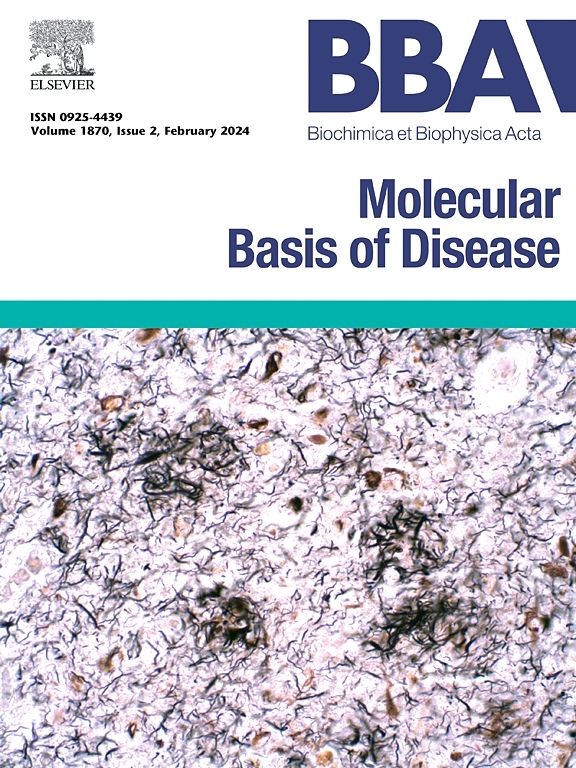TNF-α drives bladder cancer metastasis via METTL3-mediated m6A modification to promote CLASP2/IQGAP1-dependent cytoskeleton remodeling
IF 4.2
2区 生物学
Q2 BIOCHEMISTRY & MOLECULAR BIOLOGY
Biochimica et biophysica acta. Molecular basis of disease
Pub Date : 2025-03-19
DOI:10.1016/j.bbadis.2025.167811
引用次数: 0
Abstract
Background
Bladder cancer (BCa) metastasis is a multi-step process triggered by cytoskeleton reorganization. However, the regulation mechanism of cytoskeleton reorganization in BCa remains ambiguous. This study elucidated the influence of tumor necrosis factor-alpha (TNF-α) in cytoskeleton remodeling during BCa metastasis and its possible mechanisms.
Methods
Colony formation, scratch, transwell, and the nude mouse model were adopted to evaluate the growth and metastasis. Molecular expression was assessed by immunohistochemical staining, quantitative real-time PCR (qRT-PCR), and Western blotting. The N6-methyladenosine (m6A) level was detected by methylated RNA immunoprecipitation (MeRIP). Protein interaction was validated by Co-immunoprecipitation (Co-IP). Immunofluorescence staining was used to identify rearrangement of actin filament fibers (F-actin) and protein colocalization.
Results
TNF-α facilitated cytoplasmic linker associated protein 2 (CLASP2) and methyltransferase like 3 (METTL3) expression in a dose (10–50 ng/mL)-dependent manner in BCa. CLASP2 high expression suggested a shorter overall survival of BCa patients. CLASP2 deficiency suppressed BCa cell proliferation, migration, and invasion via disrupting F-actin cytoskeleton. Mechanistically, TNF-α promoted METTL3-mediated m6A modification of CLASP2 to enhance CLASP2 mRNA stability. Moreover, CLASP2 directly interplayed with IQ motif containing GTPase activating protein 1 (IQGAP1) to regulate F-actin cytoskeleton remodeling. In vivo data demonstrated that inhibition of METTL3/CLASP2 axis delayed lung metastasis in nude mice.
Conclusion
TNF-α favors BCa cell metastasis, which involves METTL3-mediated m6A modification of CLASP2 that interacts with IQGAP1, thus leading to F-actin cytoskeleton remodeling. Our findings suggest targeting TNF-α/METTL3/CLASP2/IQGAP1 axis as a potential avenue for promising treatment for BCa.
TNF-α通过mettl3介导的m6A修饰促进CLASP2/ iqgap1依赖性细胞骨架重塑,从而驱动膀胱癌转移。
背景:膀胱癌(BCa)的转移是一个由细胞骨架重组引发的多步骤过程。然而,BCa细胞骨架重组的调控机制尚不清楚。本研究阐明肿瘤坏死因子α (tumor necrosis factor -α, TNF-α)在BCa转移过程中对细胞骨架重塑的影响及其可能机制。方法:采用菌落形成法、划伤法、transwell法和裸鼠模型观察其生长和转移情况。通过免疫组织化学染色、实时荧光定量PCR (qRT-PCR)和Western blotting检测分子表达。采用甲基化RNA免疫沉淀法(MeRIP)检测n6 -甲基腺苷(m6A)水平。通过共免疫沉淀(Co-IP)验证蛋白相互作用。免疫荧光染色检测肌动蛋白纤维(F-actin)重排和蛋白共定位。结果:TNF-α促进BCa细胞质连接物相关蛋白2 (CLASP2)和甲基转移酶样3 (METTL3)的表达,并呈剂量依赖性(10-50 ng/mL)。CLASP2高表达提示BCa患者总生存期较短。CLASP2缺乏通过破坏f -肌动蛋白细胞骨架抑制BCa细胞增殖、迁移和侵袭。在机制上,TNF-α促进mettl3介导的m6A修饰CLASP2以增强CLASP2 mRNA的稳定性。此外,CLASP2直接与含有GTPase激活蛋白1 (IQGAP1)的IQ基序相互作用,调节F-actin细胞骨架重塑。体内数据表明,METTL3/CLASP2轴的抑制延缓了裸鼠肺转移。结论:TNF-α促进BCa细胞转移,其机制可能与mettl3介导的m6A修饰CLASP2与IQGAP1相互作用,从而导致F-actin细胞骨架重塑有关。我们的研究结果表明,靶向TNF-α/METTL3/CLASP2/IQGAP1轴是治疗BCa的潜在途径。
本文章由计算机程序翻译,如有差异,请以英文原文为准。
求助全文
约1分钟内获得全文
求助全文
来源期刊
CiteScore
12.30
自引率
0.00%
发文量
218
审稿时长
32 days
期刊介绍:
BBA Molecular Basis of Disease addresses the biochemistry and molecular genetics of disease processes and models of human disease. This journal covers aspects of aging, cancer, metabolic-, neurological-, and immunological-based disease. Manuscripts focused on using animal models to elucidate biochemical and mechanistic insight in each of these conditions, are particularly encouraged. Manuscripts should emphasize the underlying mechanisms of disease pathways and provide novel contributions to the understanding and/or treatment of these disorders. Highly descriptive and method development submissions may be declined without full review. The submission of uninvited reviews to BBA - Molecular Basis of Disease is strongly discouraged, and any such uninvited review should be accompanied by a coverletter outlining the compelling reasons why the review should be considered.

 求助内容:
求助内容: 应助结果提醒方式:
应助结果提醒方式:


